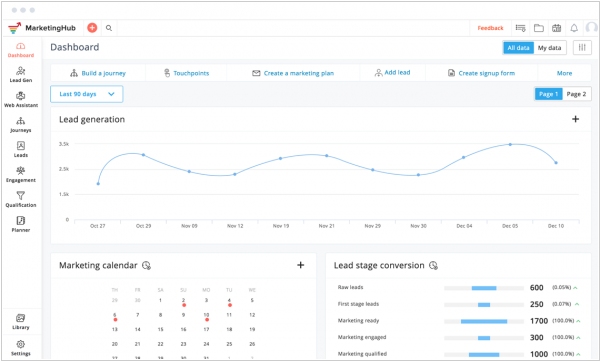
The key to an effective lead scoring system is to create a set of rules and criteria to accurately determine which leads are ready to convert to customers. This can be a combination of demographics, behavior, or other data that affect lead conversion. While some companies might use a simple point system to rank leads, others may use multiple data points to create highly customized scores.
Choosing the right metrics to measure leads and their conversion is vital to your sales team's success. You'll want to consider how many leads will convert, as well as how many of these leads will actually become customers. A lead's traits should be compared to other customers. This will allow you to target the most likely customers to sell to.

Lead scoring takes a constant effort. A well-constructed system allows your reps to effectively identify leads that are ready to buy. However, it is important to establish your business rules and metrics before you can develop a scoring system.
To measure the efficiencies of lead scoring, you should create a spreadsheet that lists the relevant metrics. You might compare, for example, the number and page views of a lead's site, as well as the time they spend on it. Finally, measure the engagement of leads with your content. These numbers will let you know if the lead would be interested in buying your product. If the number of interactions is low, you may need to make adjustments.
One of the best aspects of lead scoring lies in its ability not to convert leads to customers. This is especially important for companies with a lengthy sales cycle. Many times, less than 25% of the leads you are generating can be converted into customers. A robust system can help you weed out lower-scoring leads, and make warm leads.
It is difficult to assign the correct point value to a data points in a lead scoring program. Ideally, you'll want to assign a high value to the lead-related data point that best represents your company's objectives. That might be your revenue, or your company size. If you assign a point price to each metric, it will be easy to determine which metrics are more important than others.

The ideal process for lead identification involves selecting the most relevant demographic data points and assigning a point score that is appropriate to the situation. Simple metrics such as how many forms or pages a lead has filled out are often overlooked. Therefore, you might need to look at more complicated calculations. But you need to make sure the lead-related data points you select aren't rote.
Close rates are one the most crucial metrics to monitor. Close rates are a great benchmark that you can use to determine the point value for each data point.
FAQ
What is the best Content Marketing platform?
There are lots of different platforms available today. Each platform has its pros, and each one has its cons. Here are some options that are popular:
-
WordPress is easy to set up, manage and maintain. A great community of users.
-
Wix – It's easier than WordPress to setup and maintain. There is no technical knowledge required.
-
Squarespace - Best option for those who already have a website.
-
Blogger - A free blogging service.
-
Medium – A place that writers can share their work.
-
Instagram - An image-based social media platform.
-
LinkedIn - A networking tool.
-
Facebook - A social network.
-
YouTube - Video sharing platform.
-
Pinterest - Image-based platform.
-
Google Analytics – Track visitor behavior.
-
Hubspot - Email marketing software.
-
MailChimp: Email marketing software.
How can you create good content?
Content should be useful, interesting, and easily shared. The best content should have a clear call-to-action, such as a button or link to allow readers to sign up to a free trial, learn more about a product, and/or purchase something from you site. Your content should include visuals to be easily shared on all platforms.
How does content-marketing work?
Content Marketing is a way to create engaging, valuable content that offers value.
When you provide helpful information, solve problems, entertain, or engage your audience, you build relationships with them. People respond well to positive messages from brands they know and trust.
People love reading about things they are interested in. Writing something interesting will make your readers return time and again.
Your content should drive people to take action - whether buying your product, signing up for your newsletter, visiting your website, or sharing your article via social media.
Content marketing should be engaging and informative.
Statistics
- An example of an overarching goal could be: "In 2022, we want to achieve a 20% increase in revenue created by organic content and generate 15,000 MQLs with a budget of $30,000." (semrush.com)
- Companies that use content marketing see approximately 30% higher growth rates than businesses not using it. (mailchimp.com)
- According to research compiled by Coschedule: Companies that publish 16+ blog posts a month get as much as 3.5x as much traffic as those that publish 0-4 posts a month. (criteo.com)
- In fact, would pay more for a better customer experience, and 86% of B2B buyers would pay more. (neilpatel.com)
- This marketing strategy landed Ford a 15.4% conversion rate. (neilpatel.com)
- Progress indicators (0–100%) allow each team member to see how attainable each goal is and understand what remains to be accomplished. (semrush.com)
- Out of the 1,500 marketers we surveyed for our State of Content Marketing report, 78% who felt their content marketing strategy was exceptionally effective in 2021 had documented their strategy. (semrush.com)
- To further show the importance of this, 89% of people have stopped doing business with a company because of a poor experience. (neilpatel.com)
External Links
How To
How to create amazing images
Images are a great way to make your content standout from others. Images are one of most effective methods of communicating ideas visually. They are great for grabbing attention and increasing engagement. They help convey complex concepts simply and effectively, and they're also useful for highlighting key points in any kind of written content (e.g., blog posts, social media updates, etc. ).
Images can be used to enhance a presentation or piece of writing. They can make it more interesting and alive. However, if you don’t know what to do with the image you choose, your results could be less impressive. Here are some tips to help you choose the best images for your next job.
-
It is important to understand what makes a photo good. Before you look at photos, there's a lot you need to know. First off, you want to pick images that are clear and concise. A cluttered image won't cut it. It won't attract attention the same way a clear, concise photo would. Avoid images that have people not smiling or staring directly into the camera. This can make it appear that you don't care about what you say. You want the image to not distract from what you are trying to convey. It shouldn't draw too much attention to the content.
-
Look for inspiration. Once you have a list of possible candidates, it is time to look through them and select those that interest you. Look at their captions first. Some photographers include these in the photo, while others write them separately. In either case, it is important to check that the caption is easy to read. Pay close attention also to the context of your photo. Is it somewhere where you might expect to find people having fun? Perhaps it looks dangerous. It might be a place that you would not normally associate with happiness. Whatever the reason for your liking the image, think about how it relates with the message you wish to convey.
-
Check out different types and sizes of images. One of the biggest benefits of using images in your content is that they allow you to highlight certain aspects of your text. You might want to include a picture of the product in action if you are writing about it. Likewise, if you've got an infographic on offer, you may want to include an image showing the presented data. These kinds of visual aids will help draw readers closer to your information, as they'll feel more connected to what you're sharing.
-
Use the right format. One of the most important factors to remember when choosing images is the file type you need to use. When working on web pages, you generally have two options: JPEG and GIF. Both of these file formats are great, but each has advantages and disadvantages. JPEG files can be used on websites as well as social media posts. They work especially well for photos, since they store large quantities of data in a compact space. They can lose their quality over time and become pixelated after a while. GIFs can be used for graphics and animation because they are smaller than JPEGs. However, they don't support transparency, making them unsuitable for photos.
-
You can also include other visuals. It's a good idea to add visuals to your content if it is difficult to think of images. This can help you make your post more effective by creating a distraction-free atmosphere for your readers. This means they're less likely to click out of the page while reading your article. Create infographics, which are great for adding visuals to your site. Infographics are very popular because they make it easy to share lots and lots of useful information. They are also great for adding visuals to your blog posts.